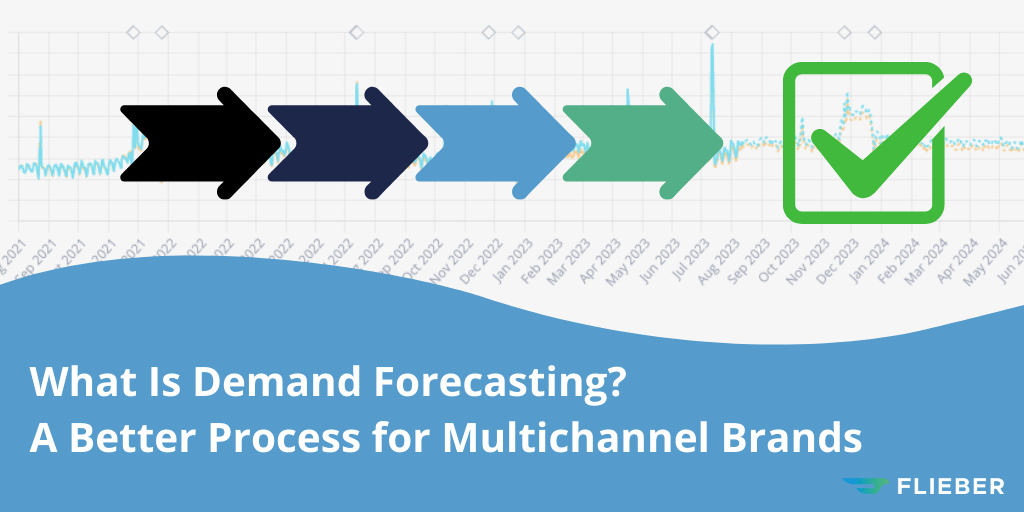If the rapid growth of the e-commerce industry has taught us anything, it’s that consumer demand can fluctuate wildly for even the simplest of reasons, throwing off your inventory forecasting.
An influencer can rave about a new product and inventory flies off the shelves. On the other hand, trends can change just as rapidly, causing once-popular items to sit stagnant in warehouses.
This volatility can make inventory forecasting increasingly difficult to begin with. Add in supply chain issues and your risk of stockouts multiplies. That is, unless your business is ready with an optimized demand forecasting strategy.
With the right approach, demand planning can serve as a guiding light to help you deliver the right products, in the right quantities, at the right time.
In this post, we’ll share key best practices and demand forecasting models to help you stabilize your inventory and grow your sales.
Table of contents
- What is demand planning?
- What are the different types of demand forecasting?
- How does demand forecasting work in e-commerce?
- How does accurate demand forecasting benefit your brand?
- 4 simple steps to better demand planning
What is demand planning?
Demand planning, or demand forecasting, is defined as a method of gathering historical and real-time data to identify the most accurate prediction of future sales.
In e-commerce, demand forecasts may be generated using data such as:
- Historical product sales performance
- Market research and consumer behavior trends
- A competing products’ sales history
- Outlier variables (promotions, weather affects, and other anomalies)
When done correctly, demand planning helps to not only avoid stockouts, prevent overstocks, and secure more sales, it also puts you in a position to unify teams and make better, data-backed decisions across the business.
With an accurate reading on product demand, you’ll be able to make high-ROI inventory purchases, scale new products faster, and enter new markets with confidence.
While smaller brands may be able to get away with a manual, spreadsheet-based demand forecasting process, a fast-growing midsize or enterprise-level business with multiple sales channels and inventory locations is going to need a more streamlined and systematized approach.
What are the different types of demand forecasting?
If you are an inventory planner or have to deal with any aspect of inventory planning, you know how complex it can be to get the right levels of inventory.
There are so many moving parts to this equation, such as seasonality, competition, supplier MOQs, freight cost, lead times, and more, all of which can make accurate forecasting feel impossible.
Here are some of the common demand planning methods that can help.
Historical Data Method
As the name implies, this method examines historical sales data to predict the inventory you’ll need in the future, based on the quantities you sold in the past. This can be highly effective if you have accurate historical data spread over a long period of time.
Market Research Method
This one is pretty self-explanatory, too — data obtained from market research, like customer surveys, is used to determine future purchases.
The more granular the data, the more informed your decisions will be, but you can still create accurate forecasts by obtaining even just a few authentic customer insights like key demographic points and opinion-based feedback.
Econometric Method
This method is a little more complex. It combines sales data with external customer factors that may impact purchasing decisions, such as personal debt, local income rates, and more.
It basically covers the “why” of customer purchasing decisions for certain regions or customer segments.
Machine Learning Method
With the power of AI and machine learning, this method uses real data including historical sales, current trends, demographics, customer insights, and more, to forecast your inventory as efficiently and accurately as possible.
For example, Flieber’s demand forecasting AI model can suggest substitutions to help you prevent stockouts for in-demand items. It can also detect sales anomalies like past stockouts, correct pandemic-affected sales patterns and other anomalies, and allow users to make real-time adjustments in the event of supply chain disruptions and emergencies.
How does demand forecasting work in e-commerce?
Whether you’re looking to reduce stockouts, streamline your inventory, or balance your forecasts after a market anomaly, demand forecasting can optimize your sales and help you build confidence in your replenishment decisions.
Here are a few examples of how real brands have used demand forecasting to better predict their inventory needs.
Example 1: Stockout prevention
A luxury bedding and linens company with $13M in revenue wants to increase sales, but is faced with repeat stockouts.
By using the historical data method, their leadership and supply chain team can obtain six months of demand forecasting insights including sales history, inventory in-transit, and past stockouts.
With greater visibility into past and future demand, the brand has seen a consistent reduction in stockouts.
Example 2: Long-term inventory planning
An electronic accessories merchant with $12.5M in revenue offers several products that come in various colors and sizes. Each item had a different SKU, leading to a massive catalog.
Since they only place orders quarterly at most, replenishment purchases have long lead times. To avoid stockouts and ensure their products meet seasonal trends, they need to automate purchasing to accurately forecast six months ahead.
Using a machine-learning based SKU analysis, the team gains full visibility. They can drill down into the demand behavior for their complete Spring collection, or access a specific forecast for a single SKUt.
Because machine learning has the ability to rapidly crunch data and deliver insights in real-time, the supply chain team can adjust the order as it gets closer to shipping, based on the latest demand data.
Example 3: Anomaly detection
A $55M home fitness company saw sales increase rapidly during the pandemic due to gyms closing and quarantine orders.
But as businesses reopened and people began heading back to their community gyms, the company was unsure how to best forecast their inventory needs.
Using a combination of historical data and machine learning to find demand patterns and automatically adjust for anomalies, they are able to accurately forecast their demand and inventory.
Garbage in, garbage out: The importance of data pre-processing in demand forecasting
One thing these brands all have in common is an inventory forecasting system that includes data pre-processing as the first most critical step.
Because you can have the most advanced models, but if you feed them with faulty data, they’ll spit out equally faulty forecasts.
By using an inventory planning platform that cleans and pre-processes your data, you can identify periods where your sales were impacted by low inventory and stockouts and substitute the average sales for what they would have been if you hadn’t experienced those events.
Here are a few ways data pre-processing improves your forecasts:
- Identify periods where sales were impacted by low inventory and stockouts
- Understand the impact of price changes or advertising spend on sales pace
- Normalize outliers
- Connect seasonal dates that do not happen on the same days every year (e.g., Black Friday)
Flieber’s machine learning models can account for complex variables including:
- Stockout substitution
- Anomaly detection (due to promotions, shopping events, or other circumstances)
- Level shifts due to changes in sales pace
- Price normalization after uncommon fluctuations
- COVID-19 sales pattern corrections
- And more
Just by doing stockout substitution, price normalization, outlier detection and adjustment for moving holidays, you can improve your forecast accuracy by over 40%.
How does accurate demand forecasting benefit your brand?
The sales-draining drawbacks of inventory stockouts are well known. However, they’re only one part of the problem. Overstock and deadstock can also have a big impact on your cash flow.
Accurate demand forecasting can mean the difference between hitting the market successfully with your next product launch, or losing out on profitable opportunities due to a lack of capital and sky-high storage fees.
Efficient demand planning can help with all of these issues, and more. Here are some of the ways demand forecasting can benefit your brand.
Consistently hit your sales targets
With a unified inventory and supply chain platform, you can:
- Align demand and inventory across the product portfolio
- Adjust sales pace and inventory to avoid stockouts and overstocks
- Maintain customer loyalty and brand reputation
By syncing demand with inventory in real-time, you can consistently achieve your top-line targets now and in the future.
Strengthen your cash flow
Accurate demand forecasting can also have a major impact on your ability to scale, without the need for external funding.
With less capital tied up in inventory, you’ll have more resources to:
- Increase ad spend on top-performing products
- Negotiate better terms with suppliers and 3PLs
- Reduce your risk for new product launches
- Expand into new markets or sales channels
- And more
Healthy cash flow puts you in a better position to act on profitable growth opportunities as they come up.
For example, if your demand forecasting reduces the amount of working capital locked up in deadstock, you’ll have more liquid capital available to reorder inventory if one of your best-sellers goes viral.
Reduce multichannel complexity
With the rise of omnichannel retail, endless aisles, and wholesale inventory, increased inventory complexity is becoming business as usual in the modern world of commerce.
Your demand forecast will need to account for market fluctuations, price changes, and sales outliers across multiple stores, fulfillment centers, and distribution centers to identify the most likely sales patterns for your products.
With a process that unifies all your sales channels and inventory locations, you’ll have full visibility into your:
- Demand level data across all brands and SKUs
- In-stock and in-transit inventory
- Portfolios of SKUs per supplier
- Complete supply chain network
Align your teams around a single forecast
When you’ve got multiple teams with their own needs, it can be difficult to keep everyone on the same page. The result is damaging silos that could lead to missed delivery deadlines and lost sales opportunities.
With a single accurate demand forecast for your entire operation, your team will be able to:
- Gain full visibility in your inventory and supply chain positions
- Access a quick and complete reference for sales data
- Make educated replenishment choices without switching between multiple systems
- Free up more time for collaboration and innovation
With a shared view of product performance and forecasts by SKU and channel, the right demand forecast platform helps establish a strong baseline to help you drive meaningful discussions internally.
4 simple steps to better demand planning
Unfortunately, many forecasting methods have accuracy levels comparable to a coin toss averaging at just 57%. Here’s how to beat the odds using better demand planning methods.
1. Feed your forecasting system clean data
There’s a saying in the world of data science: Garbage in, garbage out.
The first step to driving greater accuracy is to make sure you’re using clean data.
- Start by centralizing your sales and inventory data
- Remove any false signals (e.g., sales outliers, past stockouts, etc.)
- Delete copies, mistakes, and inconsistencies
- Add any missing data
- Standardize your information input
If you start your demand forecast with clear, accurate data your accuracy will continually improve as you feed it more information. Over time, your demand predictions will become more and more reliable.
2. Keep an eye on seasonal trends
Even when the quality of your data is high, you’ll still need to adjust your forecasts for seasonality.
These tactics can help ensure accurate inventory decisions, no matter the season:
- Forecast further into the future, especially for products with long lead times
- Set up individual reordering thresholds for seasonal vs. foundational products
- Use tools like Helium 10 and Jungle Scout to track competitors' products over time
- Keep buffer stock for your best-selling products.
With a firm grasp on your seasonal sales cycles — both per SKU and at the portfolio level — you’ll always know when to push sales and when to relax them in order to stay in stock.
3. Optimize your data with real-time visibility
Historical data is crucial to demand forecasting. But utilizing real-time data can make your purchasing decisions even more accurate, while keeping you in the loop on any fulfillment delays.
With a transparent demand forecasting system, you’ll have real-time visibility into:
- Supply chain status
- Production delays
- Unplanned operational setbacks
All while taking important factors like lead time and stock levels into account.
In Flieber, you can enable deep integrations with Amazon, Walmart, Shopify or any other digital sales channel. You can also integrate your supply chain systems to unite your sales and inventory data. You and your team will have everything you need to make stronger inventory decisions from one central digital command center.
4. Plan inventory for new products
Accurate forecasts are especially hard to predict when it comes to new products with a brief sales history.
Rather than depending solely on category data, you can improve your forecast by using patterns in the sales behavior for similar products using a forecast model called Like-item Forecast.
With this model in place you can:
- Use an existing product's forecast to provide an estimated forecast for a new product
- Reduce your margin of error when planning new product inventory
- Generate a new forecast with minimal effort
In Flieber, the “New Product Forecast” allows new products in the system to behave like established ones. Simply enter the new product's launch date, select the comparable product, and you’re good to go.
Sharpen your demand forecasts with Flieber
Flieber’s demand planning platform was designed specifically for multichannel DTC retailers with complex product portfolios, lead times, and sales patterns.
And as the world of retail continues to evolve, so do we. With the help of our customers, we are constantly innovating to make demand forecasting even easier for growing retail enterprises.
Currently, Flieber achieves above 80% average sales forecasting accuracy rate for top tier products. The result is fewer stockouts, stronger liquidity, and higher margins — giving you more time, sales, and peace of mind as you continue to scale and grow.
When you’re ready to level up your demand forecasts, Flieber can help. Request access today and plan your inventory with sharper forecasts every time.



-1.png)

